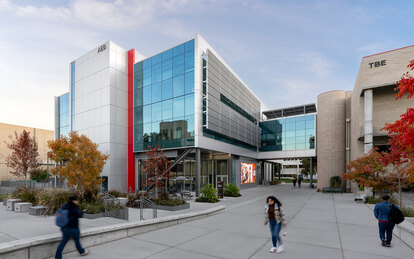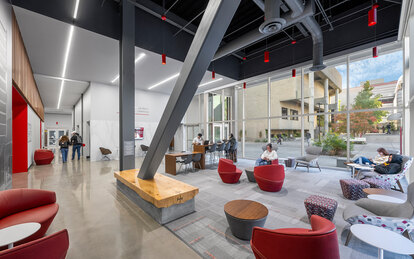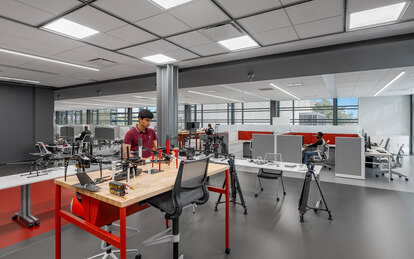University of Nevada, Las Vegas, Advanced Engineering Building
UNLV rebrands its College of Engineering with a building that expands and updates its research capabilities and gives it a prominent new presence along the campus’ main pedestrian mall.
客户
SmithGroup
位置
University of Nevada, Las Vegas
市场/服务
Architecture, Interiors, Engineering, STEM (Science, Technology, Engineering, Math), Science & Technology
大小
51,750 GSF
特色奖项
Best of the Best Projects Award. Engineering News-Record, 2024
As UNLV looked to elevate its College of Engineering to Top Tier recognition, it faced an issue common on university campuses: lack of state-of-the-art research space. It sought to augment its Thomas Beam Engineering (TBE) Complex with a new facility that could expand its research capabilities and its opportunities for greater student/researcher interaction. The university also wanted to create visibility for the dynamic learning opportunities available in its College of Engineering to prospective undergraduate students.
The Advanced Engineering Building (AEB) presents an updated view of the college and its programs, bringing student and research faculty engineering projects to the literal forefront of campus. Situated adjacent to (TBE) and along the busy Campus Mall, it is an eye-catching display of maker spaces, exhibition areas and student/researcher collaboration spaces. With its high-profile presence and contemporary design, the AEB demonstrates the university’s commitment to advanced engineering studies.
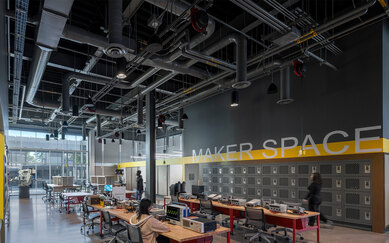
A glass lobby, LED billboards and landscaped plaza on the northwest corner beckon students arriving from the north parking areas. The building stablishes a portal that guides students along the path known as the Science and Engineering Innovation Corridor and onto the main campus mall that borders the building’s south side becoming a bold billboard for UNLV’s engineering programs. The AEB maximizes transparency and natural light with a large glass curtainwall and metal panel cladding. Because the site demanded a north-south building orientation, the team utilized a variety of external sunshade systems. A horizontal trellis on the south side and mesh screen on the east and west mitigates solar gain and glare, while creating a unique performance-based architectural aesthetic.
The design makes the most of its prominent visibility with interior and exterior learning spaces on the ground level that showcase the intriguing engineering activities happening within. From the North Mall, passersby can view a large maker space equipped with CNC machines, 3D printers and other tools, allowing students to test their ideas in a hands-on environment. This interactive environment extends to an exterior shaded patio through large pivot doors that allow students to continue their work outside. A drone aviary allows testing of unmanned aerial vehicles within UNLV’s restricted airspace and a sunken outdoor classroom offers a cool, shaded place for group study and collaboration.
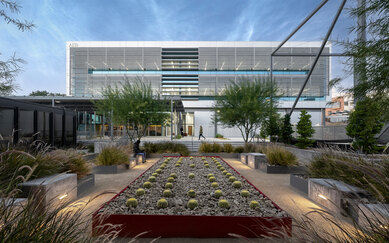
Back inside, a “flexitorium” with retractable stadium seating can host classes and speakers or be reconfigured as a flat floor for exhibitions and events. It, too, is visible from the outside and is connected to the maker space with large overhead glass doors. The second level is devoted to dry labs and the third level to wet labs, providing needed research space and recognizing the growing demand for a variety of laboratory environment to accommodate research trends. Laboratories are open and flexible, yet secure. To increase visibility of the College of Engineering’s research programs, both levels of laboratories are accompanied by a demonstration lab and collaboration spaces for students and faculty with views into the research areas. An enclosed bridge on the second level connects to the TBE, unifying the UNLV College of Engineering and raising its profile among students, faculty and industry.
Collaborating with colleagues from different fields brings fresh perspectives and diverse expertise, which fosters innovative thinking and problem-solving. The AEB’s dynamic environment allows us to tackle complex research questions from multiple angles, leading to more robust and comprehensive results.
Gabson Baguma
Civil and Environmental Engineering Graduate Student, UNLV
